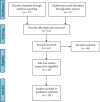Evaluation and Treatment of Vascular Cognitive Impairment by Transcranial Magnetic Stimulation
- PMID: 33193753
- PMCID: PMC7641667
- DOI: 10.1155/2020/8820881
Evaluation and Treatment of Vascular Cognitive Impairment by Transcranial Magnetic Stimulation
Abstract
The exact relationship between cognitive functioning, cortical excitability, and synaptic plasticity in dementia is not completely understood. Vascular cognitive impairment (VCI) is deemed to be the most common cognitive disorder in the elderly since it encompasses any degree of vascular-based cognitive decline. In different cognitive disorders, including VCI, transcranial magnetic stimulation (TMS) can be exploited as a noninvasive tool able to evaluate in vivo the cortical excitability, the propension to undergo neural plastic phenomena, and the underlying transmission pathways. Overall, TMS in VCI revealed enhanced cortical excitability and synaptic plasticity that seem to correlate with the disease process and progression. In some patients, such plasticity may be considered as an adaptive response to disease progression, thus allowing the preservation of motor programming and execution. Recent findings also point out the possibility to employ TMS to predict cognitive deterioration in the so-called "brains at risk" for dementia, which may be those patients who benefit more of disease-modifying drugs and rehabilitative or neuromodulatory approaches, such as those based on repetitive TMS (rTMS). Finally, TMS can be exploited to select the responders to specific drugs in the attempt to maximize the response and to restore maladaptive plasticity. While no single TMS index owns enough specificity, a panel of TMS-derived measures can support VCI diagnosis and identify early markers of progression into dementia. This work reviews all TMS and rTMS studies on VCI. The aim is to evaluate how cortical excitability, plasticity, and connectivity interact in the pathophysiology of the impairment and to provide a translational perspective towards novel treatments of these patients. Current pitfalls and limitations of both studies and techniques are also discussed, together with possible solutions and future research agenda.
Copyright © 2020 Mariagiovanna Cantone et al.
Conflict of interest statement
The authors declare that there is no conflict of interest regarding the publication of this paper.
Figures



Similar articles
-
Vascular Cognitive Impairment through the Looking Glass of Transcranial Magnetic Stimulation.Behav Neurol. 2017;2017:1421326. doi: 10.1155/2017/1421326. Epub 2017 Feb 26. Behav Neurol. 2017. PMID: 28348458 Free PMC article. Review.
-
The contribution of transcranial magnetic stimulation in the diagnosis and in the management of dementia.Clin Neurophysiol. 2014 Aug;125(8):1509-32. doi: 10.1016/j.clinph.2014.04.010. Epub 2014 Apr 30. Clin Neurophysiol. 2014. PMID: 24840904 Review.
-
Diagnostic contribution and therapeutic perspectives of transcranial magnetic stimulation in dementia.Clin Neurophysiol. 2021 Oct;132(10):2568-2607. doi: 10.1016/j.clinph.2021.05.035. Epub 2021 Jul 20. Clin Neurophysiol. 2021. PMID: 34482205 Review.
-
Cholinergic circuitry functioning in patients with vascular cognitive impairment--no dementia.Brain Stimul. 2016 Mar-Apr;9(2):225-33. doi: 10.1016/j.brs.2015.09.013. Epub 2015 Oct 9. Brain Stimul. 2016. PMID: 26515786 Clinical Trial.
-
Recent Research Progress on the Use of Transcranial Magnetic Stimulation in the Treatment of Vascular Cognitive Impairment.Neuropsychiatr Dis Treat. 2024 Jun 11;20:1235-1246. doi: 10.2147/NDT.S467357. eCollection 2024. Neuropsychiatr Dis Treat. 2024. PMID: 38883416 Free PMC article. Review.
Cited by
-
Interference of unilateral lower limb amputation on motor imagery rhythm and remodeling of sensorimotor areas.Front Hum Neurosci. 2022 Nov 3;16:1011463. doi: 10.3389/fnhum.2022.1011463. eCollection 2022. Front Hum Neurosci. 2022. PMID: 36405081 Free PMC article.
-
Editorial: Application of noninvasive neuromodulation in cognitive rehabilitation.Front Neurol. 2023 Dec 7;14:1333474. doi: 10.3389/fneur.2023.1333474. eCollection 2023. Front Neurol. 2023. PMID: 38130838 Free PMC article. No abstract available.
-
Effects of repetitive transcranial magnetic stimulation combined with cognitive training on cognitive function in patients with Alzheimer's disease: a systematic review and meta-analysis.Front Aging Neurosci. 2024 Jan 25;15:1254523. doi: 10.3389/fnagi.2023.1254523. eCollection 2023. Front Aging Neurosci. 2024. PMID: 38332809 Free PMC article.
-
Patient-specific modeling for guided rehabilitation of stroke patients: the BrainX3 use-case.Front Neurol. 2023 Nov 30;14:1279875. doi: 10.3389/fneur.2023.1279875. eCollection 2023. Front Neurol. 2023. PMID: 38099071 Free PMC article.
-
Sex differences in mild vascular cognitive impairment: A multimodal transcranial magnetic stimulation study.PLoS One. 2023 Mar 3;18(3):e0282751. doi: 10.1371/journal.pone.0282751. eCollection 2023. PLoS One. 2023. PMID: 36867595 Free PMC article.
References
Publication types
MeSH terms
LinkOut - more resources
Full Text Sources

